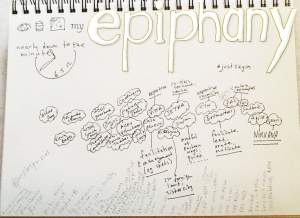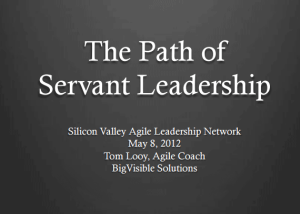A few years ago I came to realize that I am passionate about serving others. I’ve probably been aware of this sub- or semi-consciously for most of my life, but it wasn’t until I became a student of the Agile principles and methodologies that I learned the name for my greatest calling: Servant Leadership.

Tom Looy’s session at SF Agile 2012
Over my years working with and “managing” teams, I knew that traditional models of leading people were misaligned with how I was wired. The expectations described by business school (in the general sense) and my supervisors had always left me wanting more – having enough self-awareness to recognize the hard time I had with command-and-control personas. Once I became immersed in Scrum and Lean practices, I began to understand that Servant Leadership was the model I’d been operating in. My methods and inclinations began to make sense and get validation.
 In June 2012 I made my way to San Francisco Agile 2012, a conference that became the bedrock of my own ideas of building an Agile community. There I met Jim Benson, Steve Blank, Tobias Mayer, Ainsley Nies and many others who have greatly influenced the way I learn and practice. (Those three days deserve their own post…) But one session stands out more than any other: Tom Looy’s workshop on “The Path to Servant Leadership”.
In June 2012 I made my way to San Francisco Agile 2012, a conference that became the bedrock of my own ideas of building an Agile community. There I met Jim Benson, Steve Blank, Tobias Mayer, Ainsley Nies and many others who have greatly influenced the way I learn and practice. (Those three days deserve their own post…) But one session stands out more than any other: Tom Looy’s workshop on “The Path to Servant Leadership”.

All this preamble is leading up to me sharing my own path, but first I want to explain why I found the exercise valuable. As I said at the top, I felt throughout my career (if not my whole life) that I’d been called to serve, and that calling overlapped with my role as a leader. But not until I sat down and identified the discreet steps along my path did it become clear to me the extent of this self-identification. Being able to look at the arc of my development became terribly empowering, and the act of uncovering these past roles was the vehicle to my epiphany.
I recommend that all who call themselves agilists take the time to document their own path. Servant Leadership is truly at the heart of what we do leading teams through challenging transitions and powerful conversations. By making ourselves explicitly aware of the steps in our own transformational journeys, we keep our core values at the front of our minds, confident of the experiences that brought us here.
What follows is my personal account of this exercise. It may resemble a list of “jobs”, but these activities are not the typical fodder for my resume or LinkedIn profile. Instead, they add depth and complexity beyond me as a mere “job applicant” or anonymous cog in some bland organization.
Below is a timeline highlighting some roles that shaped my path of servant leadership:
- Altar Boy – Growing up Catholic, perhaps my first encounter with the opportunity to serve came via the local church. Both my brother and I became altar boys in the late-seventies and stayed on through the mid-eighties. Covering duties at Ss. Cosmas and Damian parish, we aided the fathers and brothers as well as our neighbors. (I wonder if my mom still wishes I’d become a priest?)
- Carrying Kevin’s books – While in middle school, I’d befriended a classmate named Kevin who had difficulty walking. (Though I don’t recall his specific condition, it prevented him from fully extending his arms/legs.) Carrying his own books up and down the busy halls was problematic, at best. In seventh and eight grade, Kevin and I shared a common class schedule, and I was happy to lend a friend a hand. Oddly, I recieved a commendation award each year for doing something that I’d considered a basic act of helpfulness.
- High School theater – Drama club provided an outlet for creative expression, not to mention teen-aged angst. As a freshman I’d landed a speaking role in Pippin, and as a result I was the envy of my 9th grade cohorts. Yet in my sophomore and junior years, instead of auditioning for another high-profile role, I’d volunteered for the position of assistant director. All around me, other students enjoyed their spotlight, while I worked silently coordinating schedules and projects. The satisfaction on opening night was no less sweet.
- Peterson Sound Studio – At university, I’d concentrated my undergrad years in studio recording and audio engineering. Persuing an MFA degree in filmmaking, I immediately found a job working in the sound studio: syncing mag stock in the many playback machines, supervising voice-over work, and occasionally performing a full-on master mix of other students’ 16mm masterpieces. As well, I’d served as the location sound recordist on no fewer than 27 films over a three-year span. While other students jockeyed for the title of director or cinematographer, there I was capturing and mixing the sound of their stories.
- Casa Nueva – Every film student needs a steady flow of cash to support their habit, and I was no exception. While still an undergrad, I’d landed a job washing dishes at the Worker Owned Restaurant Corp., dba Casa Nueva. When I became part owner with thirty-some others, I’d received a crash course in egalitarian work dynamics. I’d worked my way up to operations manager and discovered that I was talented in the art of facilitating our monthly meetings. Everyone had a chance to debate each topic, ranging from new menu items to what color to paint the walls. When a particularly tense meeting loomed and an even-keeled temperament was called for, the co-owners demanded I be facilitator.
- Teustepe, Nicaragua – Many causes came and went, but one of our passions was developing and maintaining relations with a sister city in Central America. After our group helped build a library in this small town 700 miles away, Bob Ramsak and I received a small grant to document how Nicaraguans (and Teustepeans, in particular) were impacted by the policies of Structural Adjustment. The pair of video documentaries we produced for public television in 1993 have also been used in schools.
- VISTA volunteer – National service came next, and I contributed my media/filmmaking skills to Rural Action, a not-for-profit economic development agency serving the Appalachian region of (mostly) Ohio. An offshoot of Americorps, the VISTA program invests in nonprofit and faith-based groups, providing difference-making volunteer experiences across the country. In addition to capturing videos/photos to raise awareness of our many programs (river cleanups, community center renovations), I helped as a carpenter, gardener and chicken processor.
- Assistant Language Teacher – With master’s degree in hand and experience making websites, I could have easily joined the movement of the mid nineties to Silicon Valley. Instead, I went to Japan. The salary of an ALT on the JET Programme wasn’t much to speak of, but the challenge of living overseas and teaching English in rural schools was formative beyond imagination. I was the first foreigner most of the children (an adults) in these villages had ever met, and I was humbled to be considered a sensei by mere virtue of the language I spoke.
- Community Television Network – Back in the U.S., I spent a few months working on films in SoCal, but quickly found that it wasn’t the lifestyle for me. I returned to the midwest and started my IT career in earnest. Still, the allure of working on a set was strong, and I soon began volunteering with CTN, the local community television station. Not much in front of the camera; my desire was to support others behind the camera – or by hanging lights or holding the boom mic.
- Toastmasters – Public speaking had always been a passion of mine, so joining was a no-brainer. It was in taking up leadership responsibilities, though, that I began to give back. Serving whatever role was necessary became my mission. I even formed a chapter in a former workplace in order to help other PMs and IT workers develop their own speaking/presentation skills. I guess that I was serving the corporation (not just individuals) in that sense.
It’s not a comprehensive list, and I find more things to add practically each time I reflect on it; but it always serves to remind me of where I come from and what I’m called to do.

